
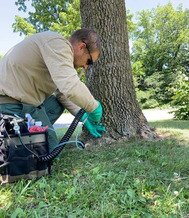
Emerald Ash Borer (Agrilus planipennis Fairmaire) is an exotic beetle that feeds on ash (Fraxinus sp.) trees. Larvae feed in the phloem and outer sapwood, producing galleries that eventually girdle and kill branches and entire trees. This native of Asia was first confirmed in Indiana in 2004. Since that time, this forest pest has spread throughout Indiana and has been detected in all 92 counties. To protect healthy ash trees, our staff treats about a hundred select ash trees on a three-year rotation in Indiana State Parks. The insecticide is injected into the base of the tree where it moves throughout the tree. If the pest is present in the tree, the treatment will kill the insect and protect the tree. The photo shows Indiana State Park Natural Resources Manager Anthony Sipes treating an ash tree at Turkey Run State Park. Each of the treated trees are numbered to track their status and health each rotation. If you see an ash tree, stop to appreciate its towering beauty and its welcoming shade. More information of the Emerald Ash Borer. |

This informal report by the Division of Entomology & Plant Pathology is a commentary on insects, diseases, and curiosities division staff encounter on a week-to-week basis. Comments and questions about this report are welcome and can be sent to your respective Inspector.
Our Website
Inspector Territories
Kristy Stultz (Nursery Inspector & Compliance Officer) -
A quick reminder for all those selling plants inside or into Indiana. Plants listed on the Terrestrial or Aquatics Plant Rules will be destroyed. You can find a list of invasive species on our website.
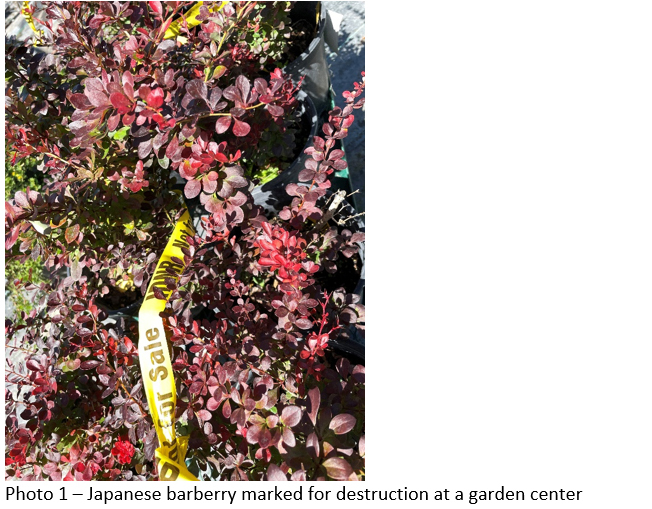
I found tulip tree scale this week in an isolated population. This soft scale insect is prolific and is a key pest of tulip, magnolia, and even linden occasionally. While there are several natural enemies, treatment may be necessary. There are several options. Horticultural oil may be used in early spring after the danger of freezing is over. The crawler stage is active from mid-August through mid-September. Remember to always read and follow the label of any product used and ensure it is labeled for the pest in question.
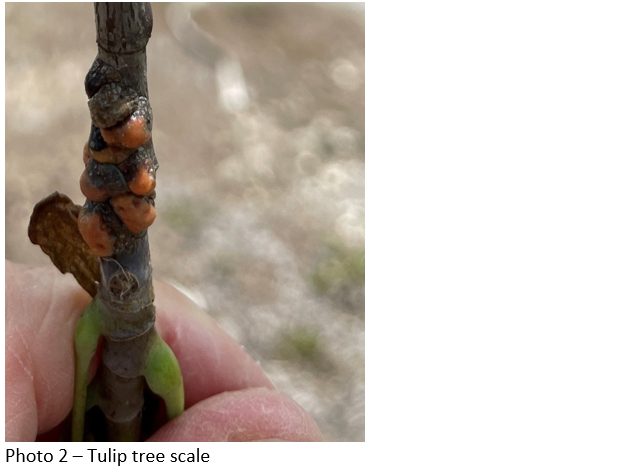
Will Drews (Nursery Inspector & Compliance Officer) -
I’ve been noticing a lot of red-headed flea beetles (Systena frontalis, RHFB) in my area, and they are causing some damage to a number of ornamental plants. RHFBs are small, shiny beetles as adults with a mostly black body and a slightly reddish head. They are called flea beetles because they jump like a dog flea when disturbed. RHFBs can be a troublesome pest in a plant nursery because they have a fairly wide host range of ornamental plants and are fairly difficult to control.
Economically important plants they feed on include hydrangeas, weigelas, roses, azaleas, viburnums, dogwoods, and more. RHFB adults feed on the foliage of the plants and can create a number of small holes, which can lead to a tattered appearance. The RHFB larvae live in the soil and will feed on the roots of the plants, but they seldom cause any damage to the plant’s overall health at this stage.
Red-headed flea beetle adults are very mobile and thus control, if warranted, can be difficult. Foliar applications of insecticides can be used on adults, but it can be difficult to get complete coverage and good control with a single application. Soil drench insecticides have been proven to be very effective at control of RHFBs at the larval stage. However, care must be taken to make sure that all the infested plants are controlled, so that the mobile adults do not come right back to the plants. For cultural control, good nursery weed control is also recommended as RHFBs can feed on a number of weedy plant species as well.
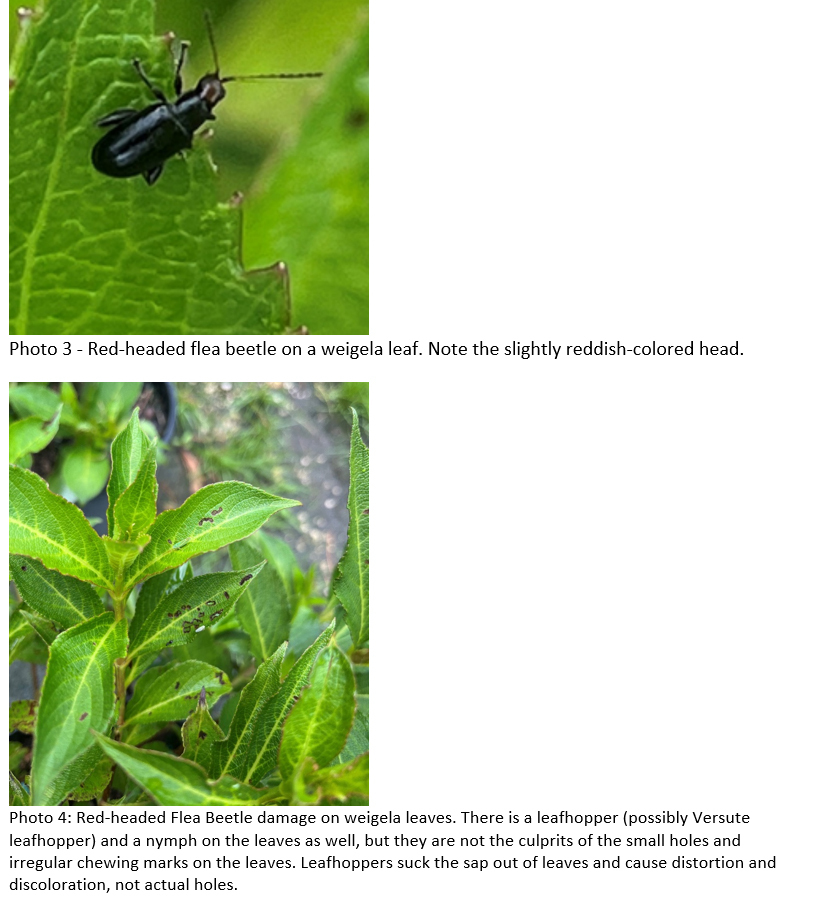
Angela Rust (Nursery Inspector & Compliance Officer) -
I had to share a fun photo of a young walking stick on a squash leaf at my house. I don’t see them very often and they have always been a favorite of mine.
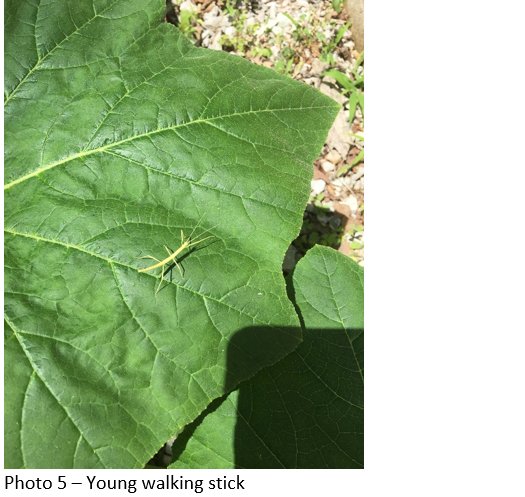
While assisting with a group nursery inspection recently I found cucumber mosaic virus (CMV) on cardinal flower (Lobelia sp.). Infection was confirmed by Immunostrip virus testing. CMV is a plant virus that can affect over 1,200 plant species worldwide, including vegetables, fruits, flowers, and weeds.
It's known for its devastating effects on members of the Cucurbit family such as cucumbers, melons, pumpkins, and squash. CMV can cause significant losses in yield and vegetable quality. Symptoms on infected plants can vary widely depending on the host. Stunting of entire plants, mosaic or mottling patterns (blotchy white, yellow, and light green areas), chlorotic ring spots on leaves and leaves with distorted shapes can all be symptoms. In extreme situations, parts of or even the entire plant may die from the disease.
CMV most commonly spreads by aphids picking up the virus as they feed on infected plants and transmitting it to healthy ones. CMV can also spread by other means. Plants confirmed to be infected should be destroyed.
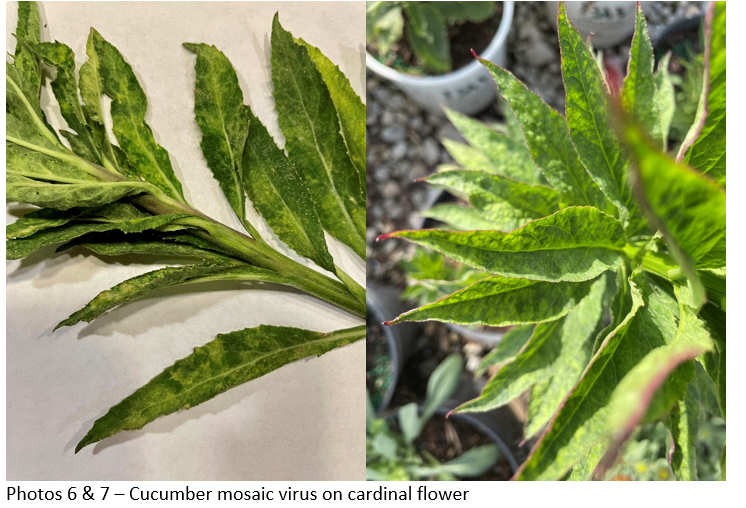
Jared Spokowsky (Nursery Inspector & Compliance Officer) -
I ran across a new invasive this past weekend. Well, maybe not new but it was the first time I’d seen it in person. Wineberry (Rubus phoenicolasius) is an invasive cane fruit from Asia that was introduced to the east coast. I found some while on a hike and decided to give them a try since they are related to our native raspberries. In my opinion, raspberries and blackberries are far better. I would say wineberry has a watered-down raspberryish taste.
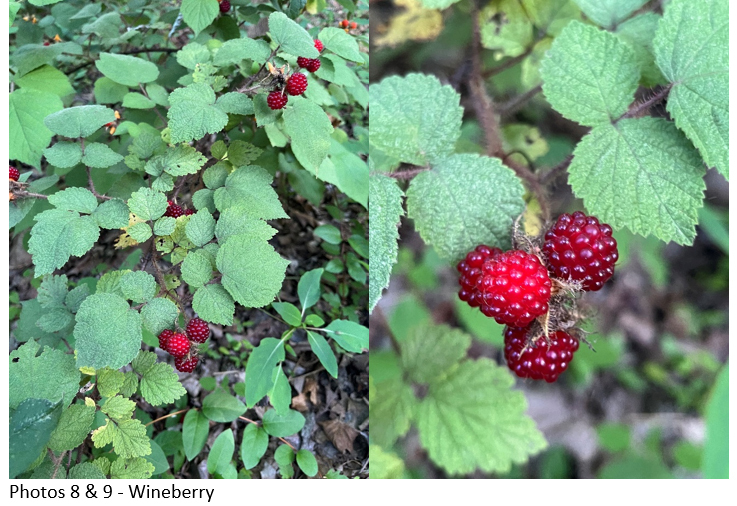
I have gotten reports from beekeepers calling me with excessive amounts of bald brood. My first question is always, “What are your mite numbers?” Bald brood is usually a symptom of Parasitic Mite Syndrome (PMS). But in multiple cases, these beekeepers have been on top of mite control or are in situations where their mite load should still be minimal. I had a local beekeeper call me with this issue, so I decided to run out and take a look. The hive was really strong. We did a mite wash which resulted in zero mites being found but the amount of uncapping was excessive - upwards of 40-50%. We were able to place some markers on certain frames and I took reference pictures. I plan on some follow-up visits which hopefully should give a little more information.
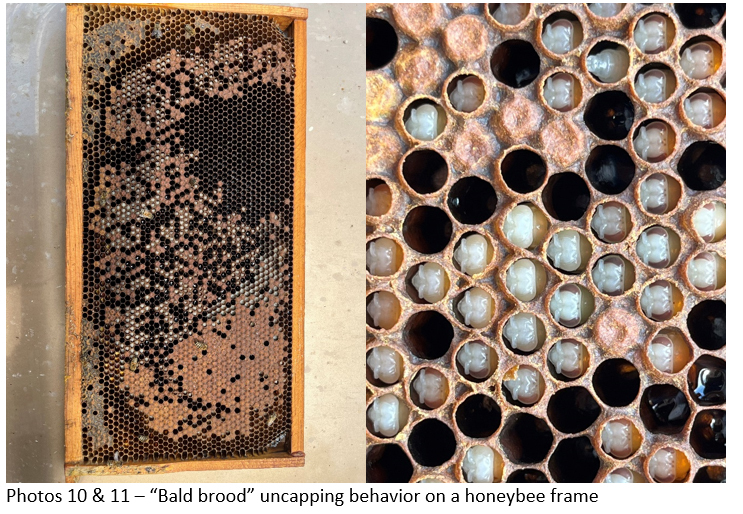
Eric Biddinger (Nursery Inspector & Compliance Officer) -
As the summer progresses, I have noticed an ever-increasing number of red headed flea beetles and the associated damage every place I visit. While not a threat to the survivability of the plants, the beetle’s damage will often make plants unsellable. If you are not scouting or managing for this critter in the nursery, I strongly suggest you start. The Purdue Landscape Report had a nice summary of control options for this insect a couple of years ago.
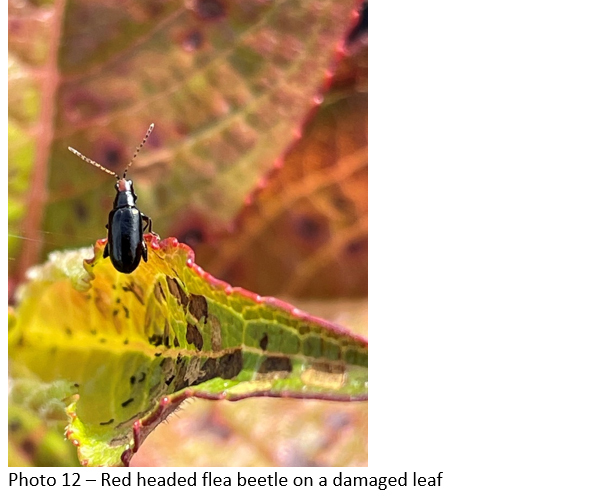
A few other finds from the last couple of weeks include spotty populations of Japanese beetle, increasing damage from maple spider mite, various rose leaf diseases including downy mildew and black spot, cottony maple scale, and so many leaf spots on oaks and maples. I also found a limited pocket of whitefly pupae on river birch – which I find memorable because they remind me of passionflower…
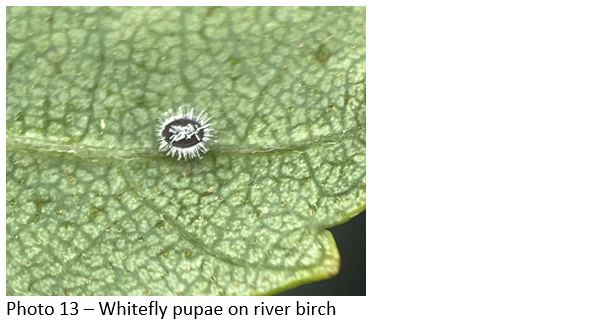
Finally, I wanted to end with a picture from a neighbor’s front yard. This was one of three Callery pears on this property that failed in a recent storm. The owners had already cleaned up the branches when I got there, but the remaining trunk tells the story of a branch union weakened by poor structure and included bark. Aside from this species’ invasive habits, its propensity to fail starting around the 15 to 20-year mark should dissuade the choice of Callery pear for landscape use. This branch failure removed nearly half of the canopy and left a gaping wound that cannot heal.
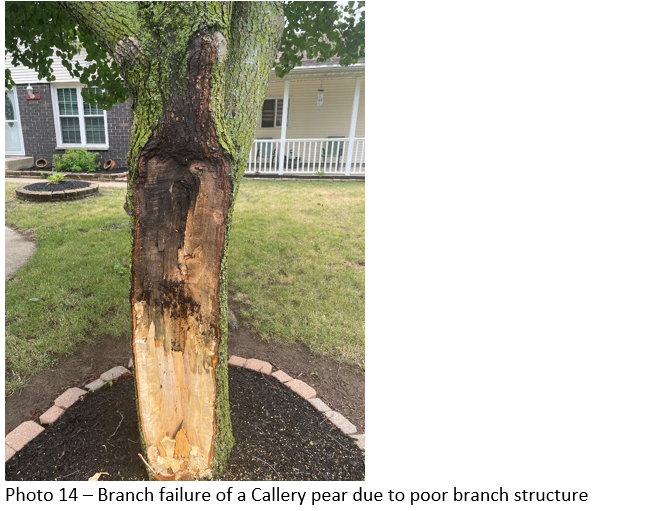
Bonnie Spindler (Nursery Inspector & Compliance Officer) -
I’m a wanderer who always enjoys checking out hedgerows, roadsides, or any wild area that might have interesting plants. Last month, a mulberry tree caught my notice. As I ambled that way, I noticed a multitude of Pastinaca sativa growing beneath it. P. sativa is also known as wild or (less commonly) poison parsnip. Don’t touch this plant! It contains toxins that cause photodermatitis. They inhibit your body’s protection from sunlight. Coming in contact with it while exposed to sunlight can cause severe blistering, rash, localized burning, and discoloration.
P. sativa is a non-native invasive weed that can be found in dry sunny areas across the state. It’s a biennial, growing close to the ground as a leafy rosette the first year and then bolting up to four feet tall, flowering, and dying the second year. It flowers from late-spring to mid-summer with hundreds of bright yellow flowers arranged in umbels. It smells similar to cultivated parsnip.
The best protection from P. sativa is avoidance regardless of what other interesting plants are nearby. If skin exposure does occur, immediately wash with soap and water and keep covered out of direct sunlight.
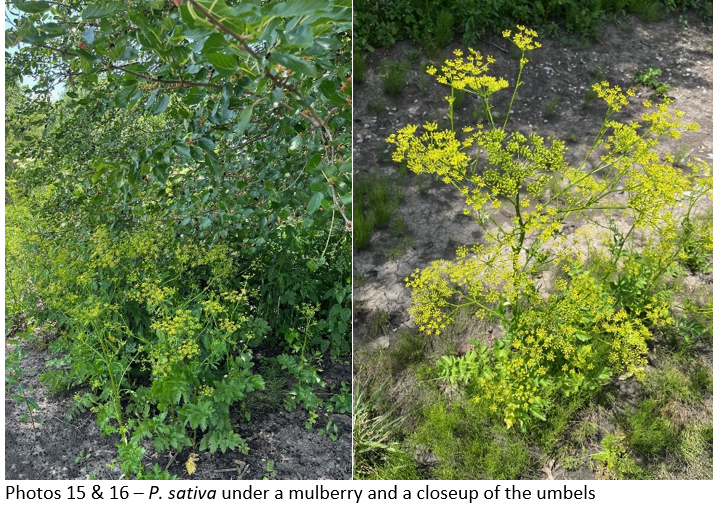
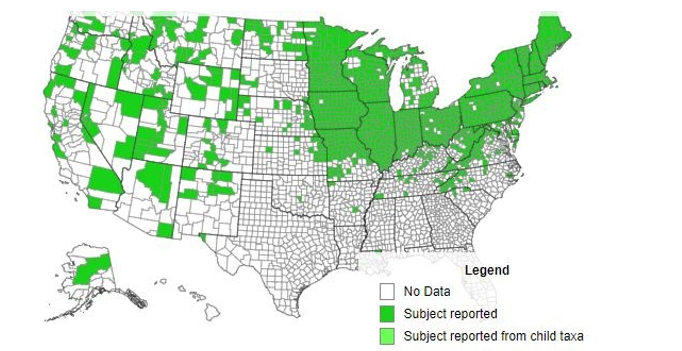
Photo 17 – EDDMaps Distribution of P. sativa, www.eddmaps.org
Washington County Local Foods Tour
A Local Foods Tour is planned for Saturday, August 17, 2024 in Washington County. The tour begins at 12:00 pm at Southern Hills Church (1645 Hwy 135 S.) in Salem. Participants will travel by tour bus to three Washington County farms including Morning Harvest Produce, Purlee Farm, and Trueblood Grain Farm to learn about lettuce and herb, beef, and popcorn production. Following the tour, participants will enjoy a meal prepared with local foods while hearing an educational presentation about the importance of supporting local businesses. Local vendors will be in available before, during, and after the meal to share about and sell their products. The registration fee is $25 per person which includes snacks and drinks during the tour and the meal. Space is limited and on a first-come-first-served basis. Register at the Purdue Extension – Washington County Office at 806 Martinsburg Rd., Ste. 104 in Salem. Contact Danielle Walker, Purdue Extension Educator, at 812-883-4601 or
The Washington County Local Foods Tour is possible through generous financial support from the Downing Charitable Trust, Washington County Community Foundation, and Washington County Commissioners. Special thanks to Washington County Farm Bureau Inc. and the SWAG Team for their partnership.

This informal report by the Division of Entomology & Plant Pathology is a commentary on insects, diseases, and curiosities division staff encounter on a week-to-week basis. Comments and questions about this report are welcome and can be sent to your respective Inspector.
Our Website
Inspector Territories
Angela Rust (Nursery Inspector & Compliance Officer) -
I’m sharing some photos of woolly apple aphid (Eriosoma lanigerum) on Gala apple. The ‘woolly’ part of the name is in reference to the waxy, cottony secretions produced by these insects, which help hide them from predators. You will notice clusters of white, cottony masses on tree limbs and trunks. Inside the masses are light, purple-colored aphids. Woolly apple aphids feed above and below the ground. Root feeding by aphids causes the most damage, particularly to young trees. Root feeding results in the development of galls that block the movement of nutrients. Yellow foliage, especially on young trees, may be a sign of root infestation by woolly apple aphid. Infestations of this pest warrant control, especially on young trees.
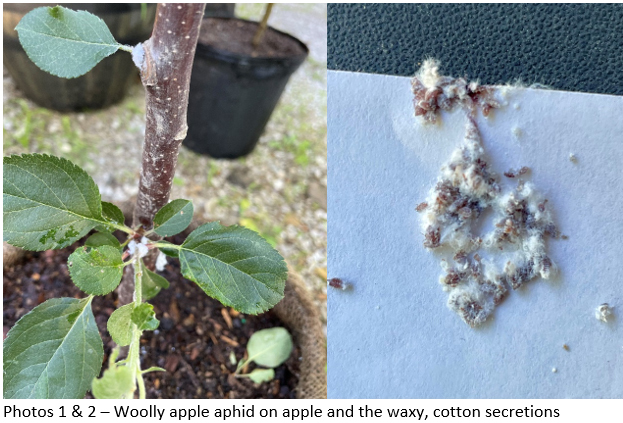
Will Drews (Nursery Inspector & Compliance Officer) -
I’ve found a couple of interesting scale insects recently during inspections. Most recently, I noticed some peculiar spots on black gum ‘Wildfire’ leaves. On closer inspection, they were being caused by little scale insects feeding on them. These scale insects are most likely black gum scale (Chionaspis nyssae). This species is a type of armored scale in the family Diaspididae. Armored scales protect themselves by creating a made of wax and other excrements. The female scales tend to have bigger and rounder coverings than the males, where they’ll lay their eggs. Armored scales are sap suckers and will feed on the fluids in plant leaves, petioles, and stems. Unlike soft scales, armored scales do not produce honeydew. Black gum scale is relatively specialized, usually only feeding on its namesake, its relative water tupelo, and a handful of other tree species.
The other scale insect I found recently was on honey locust trees. It has a similar appearance to black gum scale—albeit a little smaller—but with some more prominent ridges on the waxy covering. I’m inclined to believe that it is honey locust scale (Chionaspis gleditsiae), which specializes on honey locusts and a few other tree species. That would mean that this is another armored scale species, closely related to black gum scale.
Armored scale insects in high enough populations can cause significant damage to ornamental, shade, and fruit tree species. Dormant oil applications can be used in the dormant season to control overwintering scales on the trunks and branches. During the growing season, a number of products can be used to treat crawlers (just make sure the product mentions the ability to control armored scales on the label).
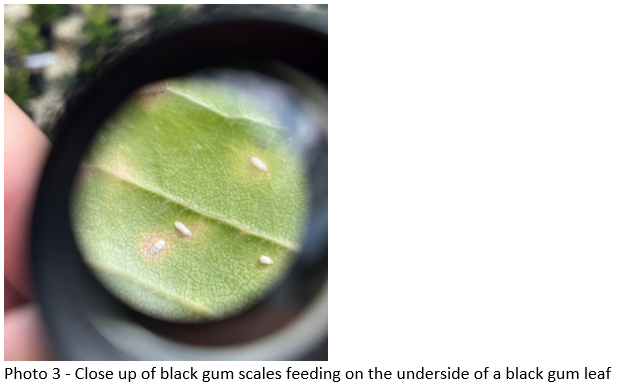
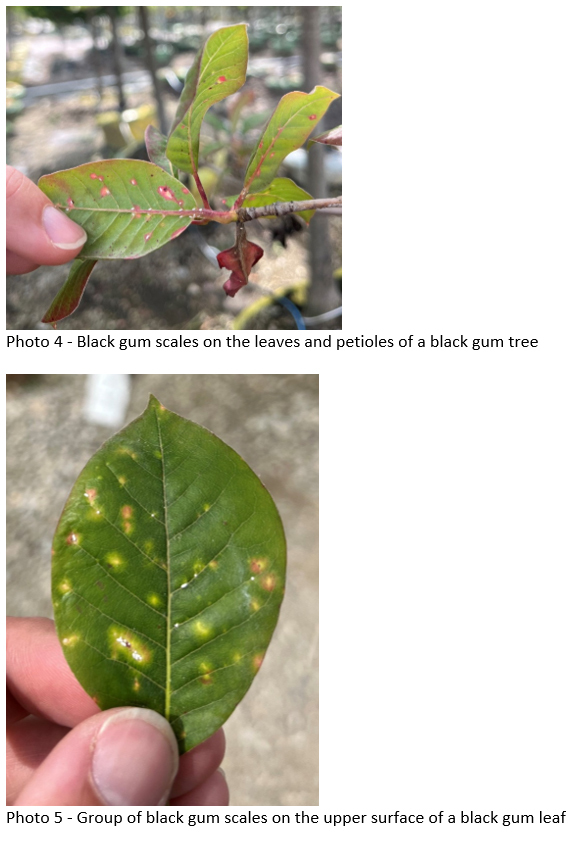

Vince Burkle (Assistant Division Director & Nursery Inspector) -
We have newly detected spotted lanternfly populations near Waterloo in DeKalb County and Kendallville in Noble County. Please be on the lookout for this insect and submit any findings to our new spotted lanternfly reporting tool.
We are also noticing the 4th instar nymphal stage of spotted lanternfly in Huntington. This is when the nymphs develop red and black body coloration with white spots.
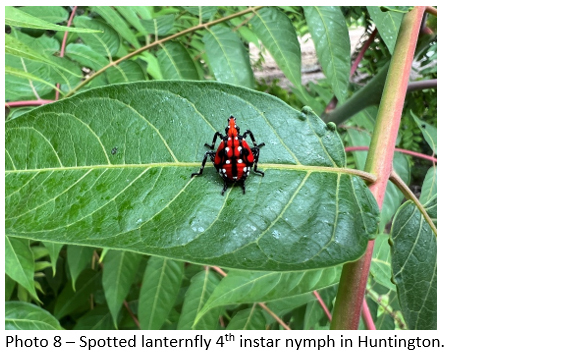
Jared Spokowsky (Nursery Inspetor & Compliance Officer) -
I have not seen much in the way of new pests this week, so it’s going to be mainly bee related info again. A lot of our summer flowers are really starting to bloom now. Mountain mints and hyssop are both just starting at my place. Both are HIGHLY attractive to honeybees as well as other pollinators. I was also fortunate to capture a honeybee working blazing star and to my surprise, it has white pollen. Blazing star isn’t particularly high on the honeybee list, but I thought it was cool anyway. I received calls from beekeepers who were afraid they had American foulbrood, but it turned out to be European in both instances. When differentiating between American and European it is important to remember that European foulbrood kills before the cells are capped while American foulbrood kills predominately after the cells are capped.
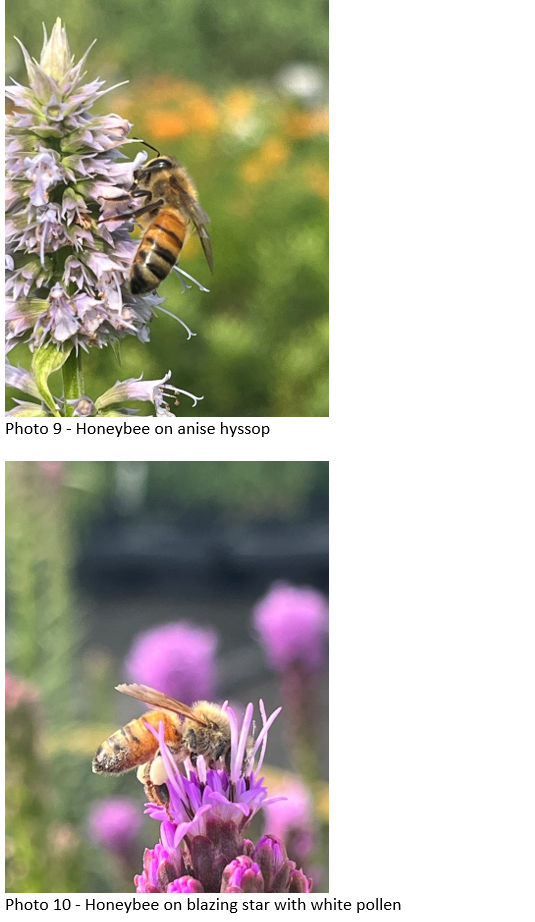
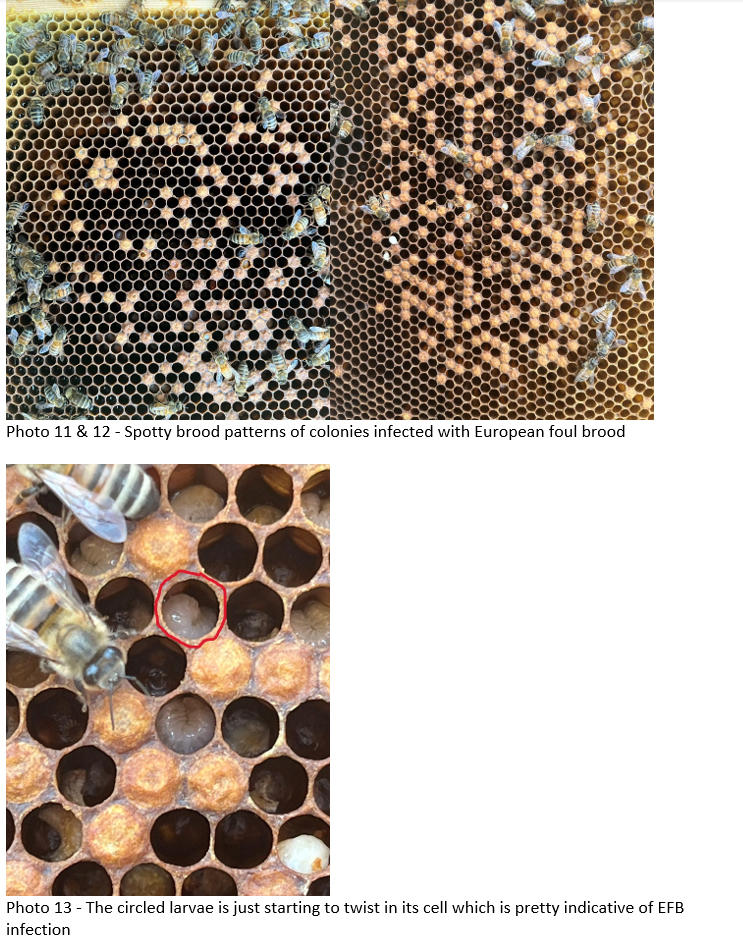



Kristy Stultz (Nursery Inspector & Compliance Officer) -
The Division of Entomology & Plant Pathology had the opportunity to spend some time at the Indiana Black Expo last week. We had a fantastic time chatting with folks about spotted lanternfly.
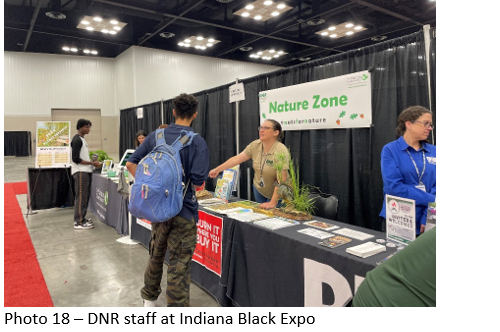
This past week, I saw more mite damage on arborvitae, but the mites seem to have vacated the premises, at least for now. On oaks, I found jumping oak gall and oak hedgehog gall, neither of which were in any great abundance. I did see one Ailanthus webworm moth (Atteva aurea) also just hanging out on the oaks.
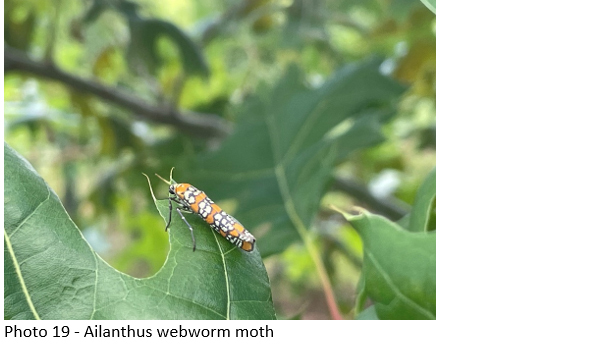
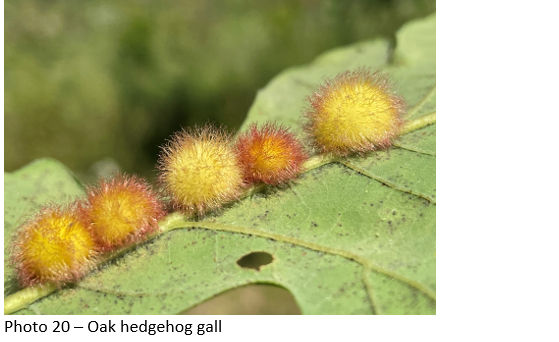
Phil Marshall (State Forest Health Specialist) -
I have had Japanese beetle adults mating and feeding on my peach trees since last week. There is also some feeding on apples but not much.
The first report of an adult spongy moth was a female moth found on a white oak in Fort Wayne. This is the first time a female moth was reported before a male moth. The female had laid eggs, so the male flight likely started June 22 or 23. Male spongy moth emergence was verified on June 27 based on reports from trap tenders checking traps. The first reports were from Fort Wayne and South Bend.
Eric Biddinger (Nursery Inspector & Compliance Officer) -
I have seen a lot of irrigation and watering issues over the last couple of weeks. In the middle of that hot, humid streak through mid-June, I was actually seeing a good bit of overwatering. The humidity was so high that plants struggled to move water through transpiration. Now that the temperature has broken it is even more important to pay attention to watering. Plants may be transpiring more water on these cooler, sunny, windy days with lower humidity. I’ve always been an advocate for watering containers based on weight. Pick up a few containers before you water. You might be surprised at the weight difference even across a single bench or table.
Has anyone else noticed issues with the red maple ‘Burgundy Belle’? The last few times I have seen this cultivar in nurseries, they have been almost uniformly chlorotic, especially when compared to other maple cultivars. I think they might not be well adapted for some of our heavier clay soils. This is something I will be looking at going forward.
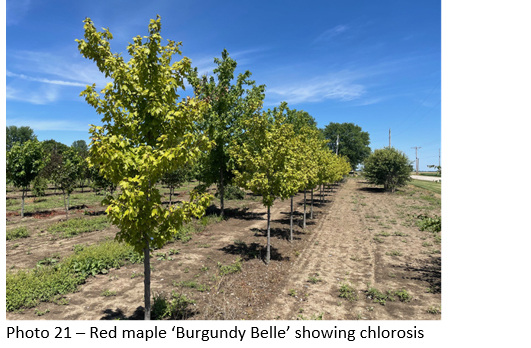
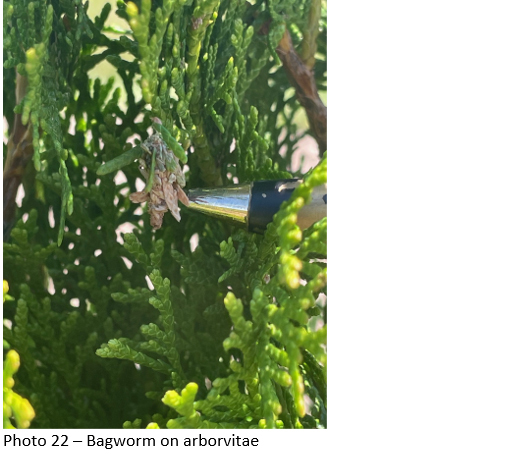

The Indiana State Department of Agriculture (ISDA) submitted an inventory of lost farmland report to the Legislative Council. In 2023, the Indiana General Assembly passed House Enrolled Act 1557, which tasked ISDA to complete an inventory of lost farmland in Indiana from 2010-2022.
ISDA determined through the inventory of lost farmland that there has been an overall reduction of farmland acres of approximately 1.5-2% from 2010-2022. This represents a loss of approximately 350,000 acres. The results show that agricultural land was most likely to be lost in areas around the edges of cities and suburban areas. The primary cause of reduction in farmland was due to residential use.
“Agriculture is, and always has been, the lifeblood of the Hoosier state,” said Lt. Gov. Suzanne Crouch, Secretary of Agriculture and Rural Development. “Data is critical for all levels of government when making decisions that may affect our rural communities and food security.”
ISDA used two sources of data – (1) parcel data from the Indiana Department of Local Government Finance(DLGF) and (2) the United States Department of Agriculture (USDA) National Agricultural Statistics Service (NASS) Crop Data Layer (CDL). Both datasets have different qualities that make them desirable for attempting to discern both the quantity of land use change and the causes of land use change.
“The inventory of lost farmland was an opportunity for ISDA and legislators to gain access to reliable data, where up until now, we could only make assumptions,” said Don Lamb, director of the Indiana State Department of Agriculture. “This information is important to have for policy development as we work to balance economic growth, food security and the preservation of agricultural land, because we know when agriculture is strong, Indiana is too.”
Despite the loss in acreage, yield data from USDA NASS shows that Indiana’s production of its cash crops has increased. In 2012, Indiana produced over 597 million bushels of corn for grain, and in 2022 yielded over 1 billion bushels. Indiana produced nearly 219 million bushels of soybeans in 2012 and saw that number increase to over 326 million in 2022.
ISDA outlined several recommendations within the report to the Legislative Council, including that legislation be passed directing ISDA to update the inventory of lost farmland every five years, starting in 2029 for a report to be published in 2030.
To view the full 2010 to 2022 report or narrative, click here or visit isda.in.gov.
SalemLeader.com
Leader Publishing Company of Salem, Inc.
P.O. Box 506
117-119 East Walnut Street
Salem, Indiana. 47167
Phone: 812-883-3281 | Fax: 812-883-4446
Business Hours:
Mondays through Fridays, 9:00am - 5:00pm
News:
news@salemleader.com
Office:
office@salemleader.com
Publisher:
publisher@salemleader.com
Business
- More Business News
- Go To Guide
- Business Directory
- Real Estate
- Auctions
Education
- More Education News
Opinion
- Editorials
- Letters to the Editor
- Columns
- Unsung Heroes
- Days Gone By
- In the Garden
- Guest Columns
- Reader's Poll
- Salem Leader Forum
- Questions and Answers
Church
- Bible Aerobics
- Church News
- Church Directory

